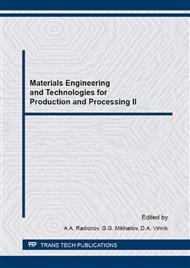[1]
Information on www. plasticseurope. org.
Google Scholar
[2]
L. Di Landro, W. Lorenzi, Static and dynamic properties of thermoplastic matrix natural fiber composites, J. Biobased Mater. Bioener. 3 (2009) 238.
DOI: 10.1166/jbmb.2009.1030
Google Scholar
[3]
T. Huq, A. Khan, K. M Tahman, Fabrication and characterization of jute fiber-reinforced PET composite: effect of LLDPE incorporation, Polym. Plast. Technol. Eng. 49 (2010) 407.
DOI: 10.1080/03602550903532174
Google Scholar
[4]
P.J. Herrera-Franco, A.A. Valadez-Gonzalez, Study of the mechanical properties of short natural-fiber reinforced composites, Compos. Pt. B. 36 (2005) 597.
DOI: 10.1016/j.compositesb.2005.04.001
Google Scholar
[5]
N.R. Galyavetdinov, R.R. Khasanshin, R.R. Safin, R.G. Safin, E.Y. Razumov, The usage of wood wastes in the manufacture of composite materials, Proceeding of International Multidisciplinary Scientific GeoConference Surveying Geology and Mining Ecology Management, SGEM 15th. (2015).
DOI: 10.5593/sgem2015/b41/s18.101
Google Scholar
[6]
M. Indicula, P.A. Sreekumar, K Joseph, S. Thomas, Natural fiberhybrid composite - Acomparison between compression molding and resin transfer molding, Polym. Compos. 30 (2009) 1417.
DOI: 10.1002/pc.20706
Google Scholar
[7]
R.R. Stork, Composites of low-density polyethylene and castor presscake. Polym. Plast. Technol. Eng. 49 (2010) 1352.
Google Scholar
[8]
V.G. Srebrenkoska, Utilization of recycled polypropylene for production of Eco composites, Gentile Polym. Plast. Technol. Eng. 48 (2009) 1113.
Google Scholar
[9]
Usta, N. Merdan, M. Akalin, Mechanical, thermal, and microstructure analysis of silk - and cotton-wastefiber-reinforced high-density polyethylene composites, Polym. Plast. Technol. Eng. 47 (2008) 502.
DOI: 10.1080/03602550801977919
Google Scholar
[10]
H. Chen, H.Y. Xue, J.H. Lin, Preparation of polypropylene-graftcardanol by reactive extrusion and its composite material with bamboo powder, J. Appl. Polym. Sci. 115 (2010) 1160.
DOI: 10.1002/app.31227
Google Scholar
[11]
Y. Kim, J.H. Peck, S.H. Hwang, W. Huh, S.W. Lee, S.C. Hong, Effect of a novel polymeric coupling agent on the water uptakeproperty and warp stability of poly(vinyl chloride)- bamboo flour composite, Compos. Interf. 16 (2009) 837.
DOI: 10.1163/092764409x12477461661987
Google Scholar
[12]
H. Wang, R. Chang, K.C. Sheng, M. Adl, X.Q. Qian, Impact response of bamboo-plastic composites with the properties of bamboo and polyvinylchloride(PVC), J. Bion. Eng. 5 (2008) 28.
DOI: 10.1016/s1672-6529(08)60068-2
Google Scholar
[13]
T. Qiang, D. Yu, Y. Wang, H Gao, Polylactide-Based Wood Plastic Composites Modified with Linear Low Density Polyethylene, Polymer-Plastics Technology and Engineering. 52 (2013) 149-156.
DOI: 10.1080/03602559.2012.734359
Google Scholar
[14]
T. Qiang, D. Yu, H. Gao, Y. Wang, Polylactide-Based Wood Plastic Composites Toughened with SBS, Polymer-Plastics Technology and Engineering. 51 (2012) 193-198.
DOI: 10.1080/03602559.2011.618518
Google Scholar
[15]
Y.J. Li, H. Shimizu, Toughening of polylactide by melt blending with a biodegradable poly(ether)urethane elastomer, Macromol. Biosci. 7 (2007) 921.
DOI: 10.1002/mabi.200700027
Google Scholar
[16]
R.R. Safin, R.R. Khasanshin, A.L. Timerbaeva, A.V. Safina, Study of the Physical and Energy Properties of Fuel Granules Based on a Thermomodified Wood Raw Material, Journal of Engineering Physics and Thermophysics. 4 (2015).
DOI: 10.1007/s10891-015-1270-y
Google Scholar
[17]
Tremblay Carl Physical properties of jack pine thermally modified at three temperature levels, The third European Conference on wood modification, Cardiff, UK, 2007, pp.183-186.
Google Scholar
[18]
N.R. Galyavetdinov, R.R. Safin, A.E. Voronin, The Mathematical Modeling of the Wood Greenery Extraction Processes, Proceeding of IEEE Conference Publications: 2015 International Conference on Mechanical Engineering, Automation and Control Systems (MEACS). (2016).
DOI: 10.1109/meacs.2015.7414885
Google Scholar
[19]
S. Butylina, O. Martikka, Comparison of water absorption and mechanical properties of wood - plastic composites made from polypropylene and polylactic acid, Wood Material Science & Engineering. 5 (2010) 220-228.
DOI: 10.1080/17480272.2010.532233
Google Scholar
[20]
R.R. Safin, R.R. Khasanshin, A.R. Shaikhutdinova, R.R. Ziatdinov, The technology for creating of decorative plywood with low formaldehyde emission, Proceeding of IOPConf. Series: Materials Science and Engineering. 93 (2015).
DOI: 10.1088/1757-899x/93/1/012077
Google Scholar


